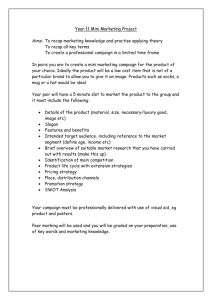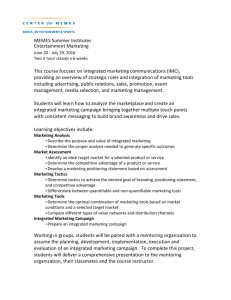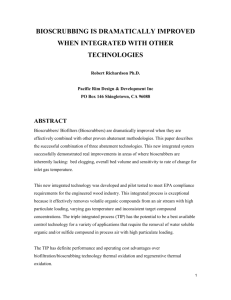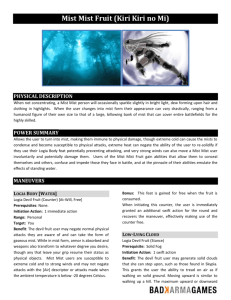International Marketing and Culture
advertisement
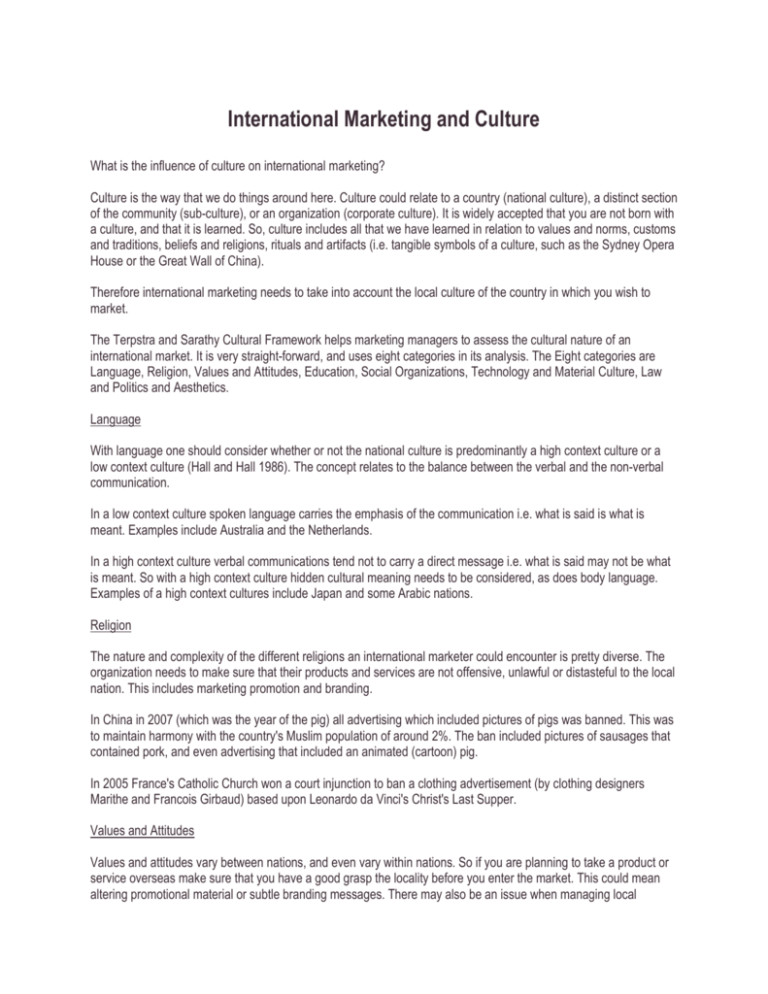
International Marketing and Culture What is the influence of culture on international marketing? Culture is the way that we do things around here. Culture could relate to a country (national culture), a distinct section of the community (sub-culture), or an organization (corporate culture). It is widely accepted that you are not born with a culture, and that it is learned. So, culture includes all that we have learned in relation to values and norms, customs and traditions, beliefs and religions, rituals and artifacts (i.e. tangible symbols of a culture, such as the Sydney Opera House or the Great Wall of China). Therefore international marketing needs to take into account the local culture of the country in which you wish to market. The Terpstra and Sarathy Cultural Framework helps marketing managers to assess the cultural nature of an international market. It is very straight-forward, and uses eight categories in its analysis. The Eight categories are Language, Religion, Values and Attitudes, Education, Social Organizations, Technology and Material Culture, Law and Politics and Aesthetics. Language With language one should consider whether or not the national culture is predominantly a high context culture or a low context culture (Hall and Hall 1986). The concept relates to the balance between the verbal and the non-verbal communication. In a low context culture spoken language carries the emphasis of the communication i.e. what is said is what is meant. Examples include Australia and the Netherlands. In a high context culture verbal communications tend not to carry a direct message i.e. what is said may not be what is meant. So with a high context culture hidden cultural meaning needs to be considered, as does body language. Examples of a high context cultures include Japan and some Arabic nations. Religion The nature and complexity of the different religions an international marketer could encounter is pretty diverse. The organization needs to make sure that their products and services are not offensive, unlawful or distasteful to the local nation. This includes marketing promotion and branding. In China in 2007 (which was the year of the pig) all advertising which included pictures of pigs was banned. This was to maintain harmony with the country's Muslim population of around 2%. The ban included pictures of sausages that contained pork, and even advertising that included an animated (cartoon) pig. In 2005 France's Catholic Church won a court injunction to ban a clothing advertisement (by clothing designers Marithe and Francois Girbaud) based upon Leonardo da Vinci's Christ's Last Supper. Values and Attitudes Values and attitudes vary between nations, and even vary within nations. So if you are planning to take a product or service overseas make sure that you have a good grasp the locality before you enter the market. This could mean altering promotional material or subtle branding messages. There may also be an issue when managing local employees. For example, in France workers tend to take vacations for the whole of August, whilst in the United States employees may only take a couple of week's vacation in an entire year. In 2004, China banned a Nike television commercial showing U.S. basketball star LeBron James in a battle with animated cartoon kung fu masters and two dragons, because it was argued that the ad insults Chinese national dignity. In 2006, Tourism Australian launched its ad campaign entitled "So where the bloody hell are you?" in Britain. The $130 million (US) campaign was banned by the British Advertising Standards Authority from the United Kingdom. The campaign featured all the standard icons of Australia such as beaches, deserts, and coral reefs, as well as traditional symbols like the Opera House and the Sydney Harbour Bridge. The commentary ran: "We've poured you a beer and we've had the camels shampooed, we've saved you a spot on the beach. We've even got the sharks out of the pool,". Then, from a bikini-clad blonde, come the tag line: "So where the bloody hell are you?" Education The level and nature of education in each international market will vary. This may impact the type of message or even the medium that you employ. For example, in countries with low literacy levels, advertisers would avoid communications which depended upon written copy, and would favour radio advertising with an audio message or visual media such as billboards. The labelling of products may also be an issue. In the People's Republic of China a nationwide system of public education is in place, which includes primary schools, middle schools (lower and upper), and universities. Nine years of education is compulsory for all Chinese students. In Finland school attendance is compulsory between the ages of 7 and 16, the first nine years of education (primary and secondary school) are compulsory, and the pupils go to their local school. The education after primary school is divided to the vocational and academic systems, according to the old German model. In Uganda schooling includes 7 years of primary education, 6 years of secondary education (divided into 4 years of lower secondary and 2 years of upper secondary school), and 3 to 5 years of post-secondary education. Social Organizations This aspect of Terpstra and Sarathy's Cultural Framework relates to how a national society is organized. For example, what is the role of women in a society? How is the country governed - centralized or devolved? The level influence of class or casts upon a society needs to be considered. For example, India has an established caste system - and many Western countries still have an embedded class system. So social mobility could be restricted where caste and class systems are in place. Whether or not there are strong trade unions will impact upon management decisions if you employ local workers. Technology and Material Culture Technology is a term that includes many other elements. It includes questions such as is there energy to power our products? Is there a transport infrastructure to distribute our goods to consumers? Does the local port have large enough cranes to offload containers from ships? How quickly does innovation diffuse? Also of key importance, do consumers actually buy material goods i.e. are they materialistic? Trevor Baylis launched the clockwork radio upon the African market. Since batteries were expensive in Africa and power supplies in rural areas are non-existent. The clockwork radio innovation was a huge success. China's car market grew 25% in 2006 and it has overtaken Japan to be the second-largest car market in the world with sales of 8 million vehicles. With just six car owners per 100 people (6%), compared with 90% car ownership in the US and 80% in the UK, the potential for growth in the Chinese market is immense. Law and Politics As with many aspects of Terpstra and Sarathy's Cultural Framework, the underpinning social culture will drive the political and legal landscape. The political ideology on which the society is based will impact upon your decision to market there. For example, the United Kingdom has a largely market-driven, democratic society with laws based upon precedent and legislation, whilst Iran has a political and legal system based upon the teachings and principles Islam and a Sharia tradition. Aesthetics Aesthetics relate to your senses, and the appreciation of the artistic nature of something, including its smell, taste or ambience. For example, is something beautiful? Does it have a fashionable design? Was an advert delivered in good taste? Do you find the color, music or architecture relating to an experience pleasing? Is everything relating to branding aesthetically pleasing? Cross Cultural Marketing Blunders Although cruel, cross cultural marketing mistakes are a humorous means of understanding the impact poor cultural awareness or translations can have on a product or company when selling abroad. Below we have provided a few classic cross cultural marketing blunders for your enjoyment. For more examples, please visit the 3 links at the end of the page. 1. Locum is a Swedish company. As most companies do at Christmas they sent out Christmas cards to customers. In 1991 they decided to give their logo a little holiday spirit by replacing the "o" in Locum with a heart. You can see the result.. 2. The Japanese company Matsushita Electric was promoting a new Japanese PC for internet users. Panasonic created the new web browser and had received license to use the cartoon character Woody Woodpecker as an interactive internet guide.The day before the huge marketing campaign, Panasonic realised its error and pulled the plug. Why? The ads for the new product featured the following slogan: "Touch Woody - The Internet Pecker." The company only realised its cross cultural blunder when an embarrassed American explain what "touch Woody's pecker" could be interpreted as! 3. The Swedish furniture giant IKEA somehow agreed upon the name "FARTFULL" for one of its new desks. Enough said.. 4. In the late 1970s, Wang, the American computer company could not understand why its British branches were refusing to use its latest motto "Wang Cares". Of course, to British ears this sounds too close to "Wankers" which would not really give a very positive image to any company. 5. There are several examples of companies getting tangled up with bad translations of products due to the word "mist". We had "Irish Mist" (an alcoholic drink), "Mist Stick" (a curling iron from Clairol) and "Silver Mist" (Rolls Royce car) all flopping as "mist" in German means dung/manure. Fancy a glass of Irish dung? 6. "Traficante" and Italian mineral water found a great reception in Spain's underworld. In Spanish it translates as "drug dealer". 7. In 2002, Umbro the UK sports manufacturer had to withdraw its new trainers (sneakers) called the Zyklon. The firm received complaints from many organisations and individuals as it was the name of the gas used by the Nazi regime to murder millions of Jews in concentration camps. 8. Sharwoods, a UK food manufacturer, spent £6 million on a campaign to launch its new 'Bundh' sauces. It received calls from numerous Punjabi speakers telling them that "bundh" sounded just like the Punjabi word for "arse". 9. Honda introduced their new car "Fitta" into Nordic countries in 2001. If they had taken the time to undertake some cross cultural marketing research they may have discovered that "fitta" was an old word used in vulgar language to refer to a woman's genitals in Swedish, Norwegian and Danish. In the end they renamed it "Honda Jazz". 10. A nice cross cultural example of the fact that all pictures or symbols are not interpreted the same across the world: staff at the African port of Stevadores saw the "internationally recognised" symbol for "fragile" (i.e. broken wine glass) and presumed it was a box of broken glass. Rather than waste space they threw all the boxes into the sea!


